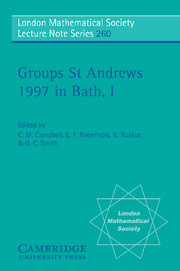Book contents
- Frontmatter
- Contents
- Contents of Volume II
- Introduction
- Radical rings and products of groups
- Homogeneous integral table algebras of degrees two, three and four with a faithful element
- A polynomial-time theory of black box groups I
- Totally and mutually permutable products of finite groups
- Ends and algebraic directions of pseudogroups
- On locally nilpotent groups with the minimal condition on centralizers
- Infinite groups in projective and symplectic geometry
- Non-positive curvature in group theory
- Group-theoretic applications of non-commutative toric geometry
- Theorems of Kegel-Wielandt type
- Singly generated radicals associated with varieties of groups
- The word problem in groups of cohomological dimension
- Polycyclic-by-finite groups: from affine to polynomial structures
- On groups with rank restrictions on subgroups
- On distances of multiplication tables of groups
- The Dade conjecture for the McLaughlin group
- Automorphism groups of certain non-quasiprimitive almost simple graphs
- Subgroups of the upper-triangular matrix group with maximal derived length and a minimal number of generators
- On p-pronormal subgroups of finite p-soluble groups
- On the system of defining relations and the Schur multiplier of periodic groups generated by finite automata
- On the dimension of groups acting on buildings
- Dade's conjecture for the simple Higman-Sims group
- On the F*-theorem
- Covering numbers for groups
- Characterizing subnormally closed formations
- Symmetric words in a free nilpotent group of class 5
- A non-residually finite square of finite groups
A polynomial-time theory of black box groups I
Published online by Cambridge University Press: 05 August 2013
- Frontmatter
- Contents
- Contents of Volume II
- Introduction
- Radical rings and products of groups
- Homogeneous integral table algebras of degrees two, three and four with a faithful element
- A polynomial-time theory of black box groups I
- Totally and mutually permutable products of finite groups
- Ends and algebraic directions of pseudogroups
- On locally nilpotent groups with the minimal condition on centralizers
- Infinite groups in projective and symplectic geometry
- Non-positive curvature in group theory
- Group-theoretic applications of non-commutative toric geometry
- Theorems of Kegel-Wielandt type
- Singly generated radicals associated with varieties of groups
- The word problem in groups of cohomological dimension
- Polycyclic-by-finite groups: from affine to polynomial structures
- On groups with rank restrictions on subgroups
- On distances of multiplication tables of groups
- The Dade conjecture for the McLaughlin group
- Automorphism groups of certain non-quasiprimitive almost simple graphs
- Subgroups of the upper-triangular matrix group with maximal derived length and a minimal number of generators
- On p-pronormal subgroups of finite p-soluble groups
- On the system of defining relations and the Schur multiplier of periodic groups generated by finite automata
- On the dimension of groups acting on buildings
- Dade's conjecture for the simple Higman-Sims group
- On the F*-theorem
- Covering numbers for groups
- Characterizing subnormally closed formations
- Symmetric words in a free nilpotent group of class 5
- A non-residually finite square of finite groups
Summary
Abstract
We consider the asymptotic complexity of algorithms to manipulate matrix groups over finite fields. Groups are given by a list of generators. Some of the rudimentary tasks such as membership testing and computing the order are not expected to admit polynomial-time solutions due to number theoretic obstacles such as factoring integers and discrete logarithm. While these and other “abelian obstacles” persist, we demonstrate that the “nonabelian normal structure” of matrix groups over finite fields can be mapped out in great detail by polynomial-time randomized (Monte Carlo) algorithms.
The methods are based on statistical results on finite simple groups. We indicate the elements of a project under way towards a more complete “recognition” of such groups in polynomial time. In particular, under a now plausible hypothesis, we are able to determine the names of all nonabelian composition factors of a matrix group over a finite field.
Our context is actually far more general than matrix groups: most of the algorithms work for “black-box groups” under minimal assumptions. In a black-box group, the group elements are encoded by strings of uniform length, and the group operations are performed by a “black box.”
- Type
- Chapter
- Information
- Groups St Andrews 1997 in Bath , pp. 30 - 64Publisher: Cambridge University PressPrint publication year: 1999
- 17
- Cited by



